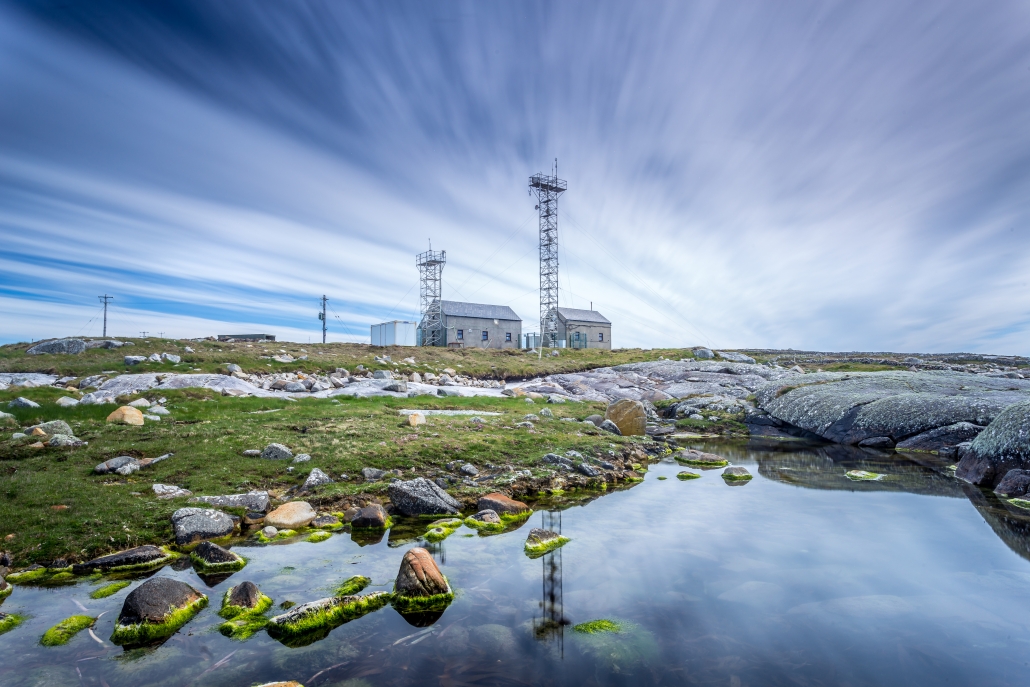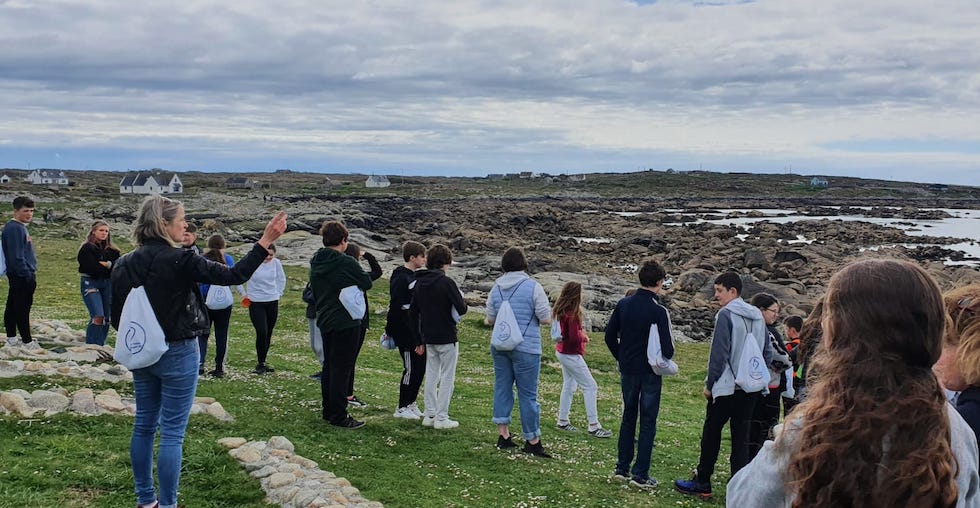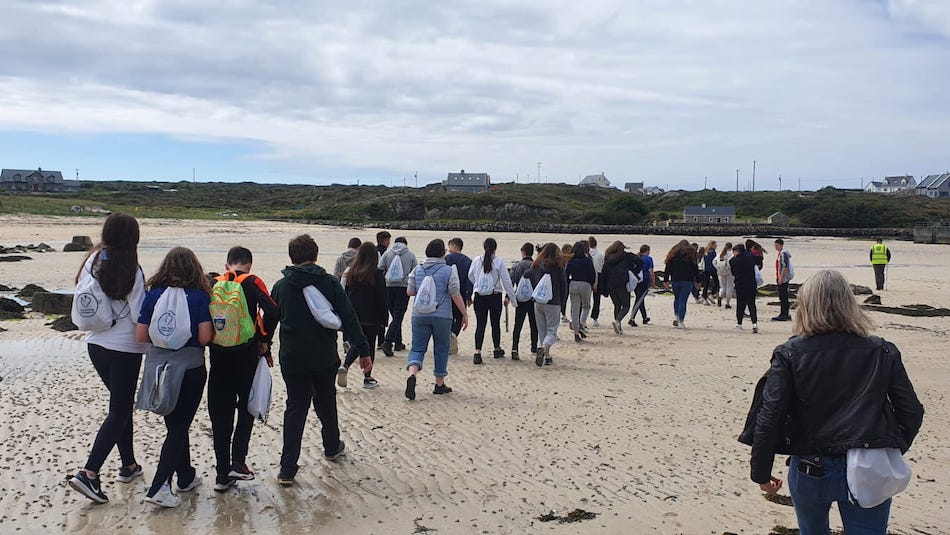
Can you start off by telling us about the work you do at Mace Head?
At Mace Head, we monitor the atmosphere by constantly sampling and measuring the air – as it comes in off the Atlantic with the prevailing south westerlies, or from the European continent when the wind changes. However unassuming, this building houses state-of-the-art meteorological instruments that measure atmospheric gases and particles. We measure the amount and types of particles; levels of greenhouse gases, such as carbon and methane; and we assess how these atmospheric components affect our health and our climate. We fuse these measurements together using data techniques to generate a robust model of the atmospheric state at our location. These can be found in our air pollution app, StreamAIR.
Our measurements have been taken since the 1980s. Like a timelapse moving image, we can look at the data to examine how our atmosphere has been changing since then. We can observe, for example, the reduction in levels of chemicals that destroy the ozone layer following the adoption of the Vienna Convention in 1985. Conversely, we can also see the relentless rise of Greenhouse Gases, despite our concerted international efforts to decarbonise our atmosphere.
Having robust data on past atmospheric states also allows us to predict potential future scenarios. Our research provides forecasts for air pollution, which helps the multi-disciplinary teams of scientists who are developing climate scenarios or pathways for our future.
Given the increasingly urgent pressures on our environment, there is a growing need to communicate our scientific knowledge about the atmosphere to the public. We all know that we need to change to continue coexisting on the planet, but to do so, we must empower the public with relevant information: we must support them in enforcing change in their own communities. Creative, collective, community action is at the heart of our current Stories of the Air/Spéirscéalta project.

How did the idea for Samhail: Stories of the Air/Spéirscéalta
The origins of the Samhail team came about in response to a call put out by the 2020 Architecture at the Edge (AATE) festival in Galway. The call asked creatives to explore the concept of the ‘public realm.’ Artists Paula McCloskey and Sam Vardy considered the atmosphere as a shared public resource, elemental to life – a stage for climate change, for transmitting sounds, viruses and pathogens. Paula and Sam contacted me and the team here to learn more about the workings of the Centre for Climate and Air Pollution Studies (C-CAPS) at Mace Head, Carna in County Galway.
Mace Head sits on the tip of Europe, facing the Atlantic Ocean. An NUI Galway and Ryan Institute Global Atmospheric facility, the observatory is home to state-of-the art instrumentation that monitors the atmospheric components important for climate change and air pollution. A critical dataset, spanning decades, has developed from these measurements. Our scientists work to uncover atmospheric processes key to regulation of the energy balance in the marine environment. These processes are hugely significant for understanding potential climate change in the North Atlantic Region.
Thanks to its unique location, Mace Head measures the pollution levels in the cleanest air in Europe, showing the extent to which the most remote, pristine areas in the world are affected by pollution. Air pollution at Mace Head can be viewed as the baseline for air pollution throughout Europe. Once we take the measurements, we separate them into categories according to the direction from which the air has travelled. This data can then tell us something about various sources of air pollution across the world. The work we do really resonated with Sam and Paula’s concept of air as a shared resource. So, we had a public discussion on the topic as part of the AATE festival.
Afterwards, we discussed ideas surrounding the atmosphere as a public space, requiring shared stewardship spanning all sectors of society. In summer 2021, we brought in our expert in science communication, education and public engagement, Dr. Mairéad Hurley (TCD). We formed the Samhail collective and have been working together since. Samhail is an Irish word meaning “model” – a reference to the atmospheric models developed from data collected in Mace Head. We use these models to inform climate change scenarios for the next 100 years. I have previously worked as a climate modeller in forecasting air pollution, so I was intrigued by the prospect of creating a different kind of model that would capture human experiences related to the atmosphere.
We strongly believe that a successful, long-lasting policy/directive for atmospheric protection is one that considers local knowledge, lived experience and heritage. Even though climate change and air pollution are global issues, responses must be sensitive to both the challenges and strengths unique to each locality. From this seed, Stories of the Air/Spéirscéalta grew – a project drawing together communities, artists, musicians and researchers in conversations about our shared air.
Throughout 2022, the Samhail collective will work with community groups in Westside, Galway City and Carna/Iorras Aithneach, Conamara. Through a series of workshops, discussions and creative events, we hope to collect Stories of the Air / Spéirscéalta, that is, tales of everyday situations in the past, present or future that relate to our consciousness of the air around us. These will later take the form of a bilingual book, to be distributed widely in early 2023.
What has been happening to date?
To date, we have met and built relationships with local organisers and representatives in Westside and Carna, further refining the project. We had a lively discussion with Westside Resource Centre and guests at their Open Door series in March. The group talked about changes in the air during lockdown and shared opinions on locally relevant climate policies.
We also had a great reception in Carna, as part of the Féile Joe Éiniú. We joined two local youth groups on a guided walk along a coastal loop that passed close to Mace Head. We discussed Mace Head research and our shared responsibility to take care of the air that connects us all.
There are excellent sustainability projects in both Westside and Carna, as well as community gardens. Westside organisers are working to install solar panels, while the Carna group are drafting a sustainable community energy masterplan. The two community groups will meet soon in Carna and explore the Mace Head research station through a guided tour.
All these conversations are helping us to visualise our final outcomes, including a storytelling workshop which will feature in arts/community festivals and schools throughout the year. We are also seeking other environmentally driven collaborators with an interest in capturing the public imagination through a combination of science and the arts.
Why is collaboration among artists and scientists important in your view?
Communicating and engaging with the public is a huge part of practicing science. Science communication is no longer about one-way transmission of knowledge and facts. As scientists, we need to listen to the public, meet them where they are, and consider how their perspectives can shape our research and communications.
Increasingly, citizens encounter data, and are asked to interpret and make decisions based on data. If we want citizens to understand how a climate scenario showing an increase in global average temperature by 2.0°C by 2100 might affect the lives of their children or grandchildren, we have a responsibility to translate our datasets into accessible, far-reaching material that tells stories.
From my experience, artists and scientists ultimately have the same goal: to shed light on processes and experiences that are important in the world. Although we employ different tools and methods, we share the same goal of affecting positive change in society. Environmental protection requires a societal-wide shift. We need to mobilise our aggregated skills across disciplinary boundaries to create a different future. New ways of thinking, working, and creating knowledge.
Artistic work evokes an emotional response in a way that traditional science communication cannot. Artworks can be viewed as conduits that allow messages to really strike a chord with the public, invoking action on climate change. It is vitally important that atmospheric and climate scientists work with the public to ensure that no citizen is left out of the climate conversation. Through this transdisciplinary approach to collective learning, we can recognise that solutions come from locally embedded knowledge as well as “expert” institutions.
Long-lasting climate solutions should be co-created with all stakeholders affected by the problem at hand. When it comes to climate change, all inhabitants and species are stakeholders. While technological and scientific innovations are key in mitigating and adapting to climate change, collaborations across art and science remind us of the importance of place, history and imagination. These are all core factors in this project.
Various community groups are now driving significant climate action across Galway, and all over the country. We are delighted to have connected with organisations embedded in these communities, such as Baboró, Bádóirí an Chladaigh, Westside Resource Centre, Coiste Stiúrtha Pleanála Teanga Chonamara Láir, Fighting Words Conamara, Ealaíon na Gaeltachta, and Galway City Museum. We look forward to working closely with these organisations to bring this project to the public.
What can we do to ensure under-represented communities have a voice in conversations surrounding environmental challenges?
So many people are aware of these challenges and care about the environment, yet we are often overwhelmed by information, and left feeling powerless to act. Climate action may also seem unattainable for citizens already under immense pressure, whether that’s societal, time or financial pressure. Vulnerable and marginalised members of society bear the burden of these pressures.
Only when all voices are heard and considered can we truly imagine a just transition for a more sustainable future. As part of this project, we want to engage those in rural Gaeltacht regions who do not have access to regular public transport, those who rely on turf for home heating. We will also work with people in Galway city that might identify as the “squeezed middle” – members of society who are time-poor, locked into economic situations that make positive climate choices seem unattainable. For example, someone priced out of the housing market has little control over household energy consumption.
We will work too with older members of society, who have a wealth of knowledge and experience having lived through the pre-consumerist era. Drastic change is essential to environmental sustainability, but policy makers must suggest changes that are fair and attainable to members of the public. There are complex pressures to be considered.

How do you foresee this project developing at a local and global level?
We envision that the workshops will include two-way dialogue with policymakers at local level (Galway city and county), giving way to effective environmental policy where a range of voices are considered. In this way, Samhail will provide pathways to economic and social empowerment through policy change. By 2025, we would love to see the Samhail project and particpants influencing policy action in Galway city and county.
We also envision that the Samhail workshop model could be scaled beyond Galway. To this end, the final evaluation report will also include a Samhail ‘blueprint’ – a resource to support other groups to recreate this process. This will not be limited to atmospheric or climate research. It can be adapted to focus on other STEM-related societal issues and challenges, such as ocean and water, public health, or data literacy. We hope that the Samhail blueprint will be used by other community groups around Ireland, and we look forward to providing support and advice to other groups interested in using and adapting the approach.
What impact does a project like this have on participants?
From our initial workshops, we feel that there is immense value in coming to a workshop that’s all about co-creating knowledge, rather than delivering a workshop. Participants become animated and forthcoming, and these workshops can be immensely enjoyable. During one workshop in Westside, we spoke to older members of the community about air pollution and climate change. The participants were not entirely sold on the theme, as they felt that they were increasingly burdened by policies, taxes and directives in the name of environmental protection. However, once they understood that we wanted to hear their experiences, not to simply instruct them on best practice, there was a major positive shift in atmosphere. Stories were recounted about changes in society. Skills, experience and existing projects were identified, and solutions began to flow. Participants were active and engaged: the next step is to share these stories with policy makers and influencers in local and national government.
Stories of the Air/Spéirscéalta is funded by SFI Discover. Samhail collective is made up of Liz Coleman, Mairéad Hurley, Paula McCloskey and Dr Sam Vardy.
Profiles

Liz Coleman is a researcher in NUI Galway specialising in climate modelling & air quality forecasting. She has a comprehensive understanding of the interdependent processes that affect, and are affected by climate change. She has studied the interactions between air quality and climate, uncovering instances where policy addressing one atmospheric issue exacerbated another issue – e.g. promotion of climate-neutral wood-burning fuels reduces air quality, or promotion of power-intensive “clean” technology increases energy demand and contributes to the relentless rise in atmospheric global greenhouse gases, accelerating climate change. Liz’s research has recently focussed on scientific strategy for integrated atmospheric assessment towards co-beneficial policy, leading the EPA-funded ANIAR initiative to strengthen international research connections, to assess the major societal challenges posed by air pollution and to form a scientific international alliance across disciplines to produce scientific outputs for the benefit of society.
Liz has engaged the public with atmospheric science in novel ways, as chief scientist in the development of interactive air-quality forecasting app StreamAIR, and leading citizen science projects using low cost sensors. She currently lectures in the School of Physics, providing courses through Irish and passionately promotes interdisciplinary collaboration and science public engagement, bringing the climate conversation to the communities, especially those marginalised and often omitted from the discourse.